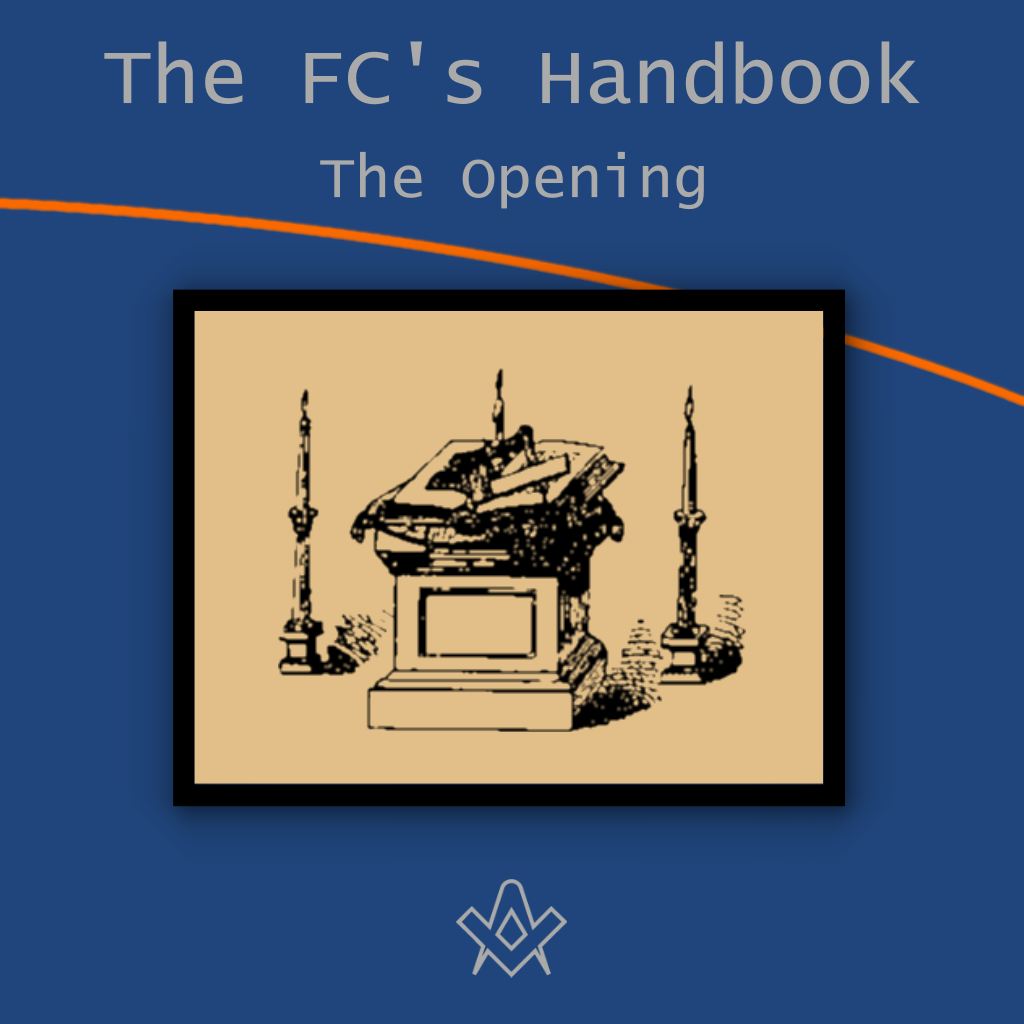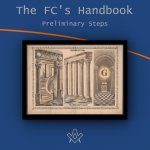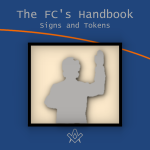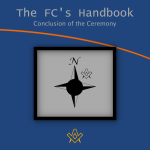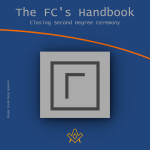The questions which are put to the candidate are really a test of the lectures, which today, unfortunately, are hardly ever given in open Lodge.
CHAPTER I – Preparation, past word and opening ceremony
The system as codified at the beginning of the 19th Century was really a most efficient method of educating the candidate and had been carefully arranged so as to make sure that only when he was properly prepared should he come forward to be passed to the second degree.
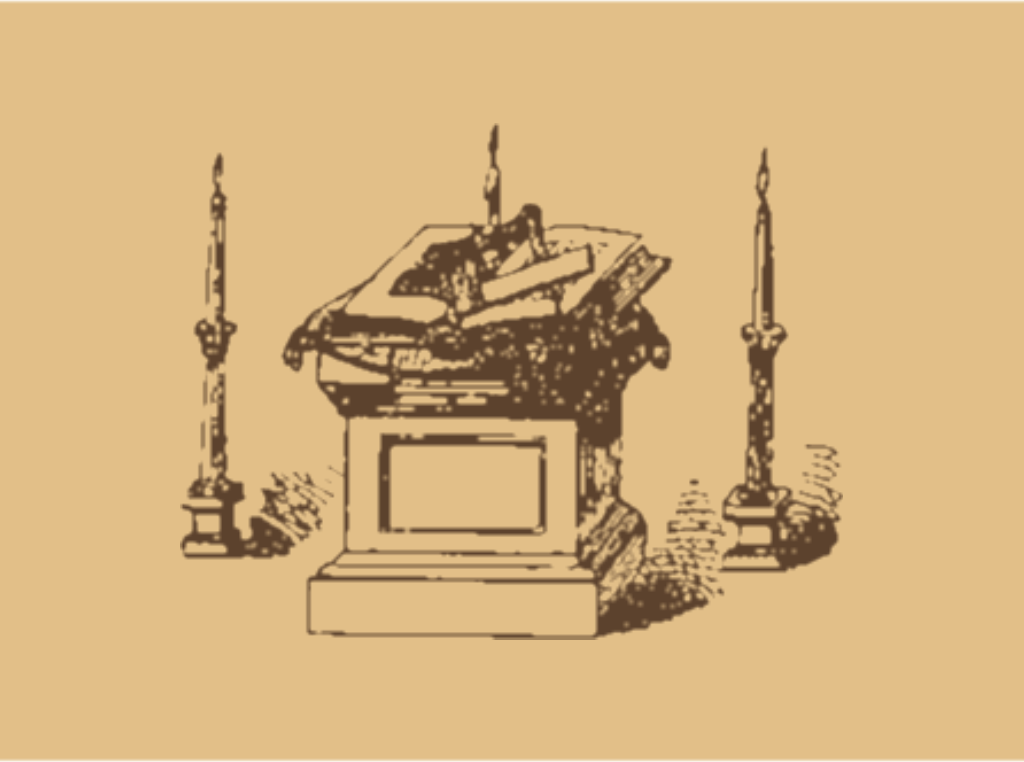
Compasses placed in a lodge of Fellowcraft Masons, ”One point elevated above the square.”
IMAGE LINKED: Duncan’s Masonic Ritual and Monitor (1866) Attribution 4.0 International (CC BY 4.0)
After having passed through the ceremony of initiation, a summary of its main tenets, illustrated as it were on the blackboard, was given to him in the form of a lecture on the Tracing Board.
The Tracing Boards were originally drawn in sand on the floor of the lodge and therefore correspond closely with the pictures and diagrams used among primitive savages in the initiatory rites of a boy into manhood.
These primitive tracing boards are still drawn on the earth by means of specially prepared and consecrated flour, and are an essential part of the ceremony.
Today the Masonic tracing board has degenerated into a somewhat crude painting on canvas stretched on a wooden frame, and its original purpose is therefore apt to be overlooked by the candidate.
This is peculiarly so in the case of the first degree tracing board, since the lecture on it is very seldom given.
In the second degree, as will be shown later, the tracing board still plays a very important part, and we shall have occasion presently to consider it in full, but the connection of the tracing board with the questions must be grasped-hence this short preamble.
Under the old system, at the next meeting of the lodge the W.M. went through the lecture proper. He asked the S.W. a sort of catechism, which the latter had to answer.
This would take well over an hour, or, in other words, as long as the ceremony of initiation.
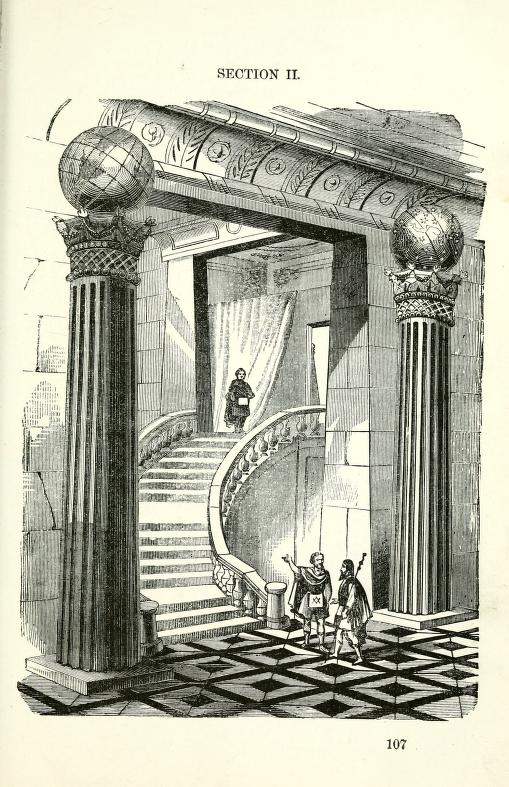
Second Degree Tracing Board.
IMAGE LINKED: General Ahiman Rezon, Daniel Edgar Sickels, 1867 Attribution 4.0 International (CC BY 4.0)
This catechism gave the exoteric meaning of most of the ceremony, together with a fair amount of traditional history of real interest.
Undoubtedly much of it was allegorical, and although the bulk of it was 18th Century work, nevertheless it contained several very striking reminiscences of the Ancient Wisdom.
For example;
Q.-” Whence come you ? “
A.-“From the west”.
Q.-“Whither directing your feet?”.
A.-“To the east. in search of a master”.
Here we have something of deep symbolical meaning, and of peculiar significance in view of a slightly different, though cognate, phrase in a later degree.
As, however, we are not attempting to interpret the meaning of these lectures in this book, we must pass the matter by, with the hope that our readers will make a point of obtaining a copy of them (purchasable at any Masonic furnishers) and study them at their leisure.
But the point which must be realised is that, while the tracing board is a summary of the first degree lecture, the questions asked of a candidate are on that lecture itself.
In short, the candidate. has to pass an oral examination, and the last question, namely, “These are the usual questions, I will put others, etc.,” although to-day practically meaningless, had originally an excellent object.
It indicated that the candidate, and also the other members of the lodge, had heard the full lecture and that the former must be prepared to answer any question on it.
In the North of England it is very usual, in addition to these questions, to ask the candidate to repeat the whole of his obligation and if he is unable to do so his passing is deferred until he can.
Turning to the questions themselves, it will be noticed that great stress is laid on the fact that the candidate must be properly prepared.
It is probably little known to most brethren, but well worth bearing in mind, that the Ancient Kabbalists had a secret interpretation of the Old Testament, and one of the keys was to read backwards the Proper Names contained in those books.
Now, if the words dedicated to the first and second degrees are read backwards, instead of the official interpretation given, they produce the phrase, “Being fortified by the practice of every moral virtue, we are properly prepared.”
The significance of this in relation to what has gone before, and also to what will follow, is self-evident.
The inner meaning of the manner of preparation having been given in the E.A.’s Handbook, it is unnecessary to write further on the subject, but of course if any of our readers have not seen that book they should certainly get it, as otherwise they will fail to understand the importance of these early questions.
We now come to the question which is rigidly termed a paradox.
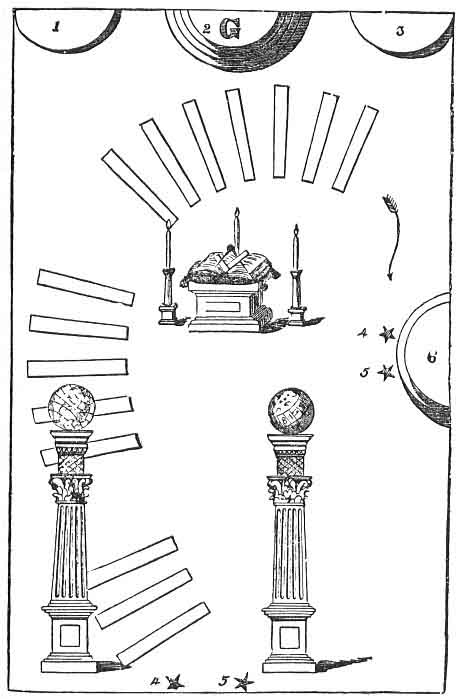
Representation of the Craftsman’s Road to the Middle Chamber of King Solomon’s Temple.
1. Treasurer 2. Worshipful Master. 3. Secretary. 4. Conductor. 5. Candidate. 6. Junior Warden.
The explanation thereof, though ingenious, is obviously somewhat Jesuitical.
The truth of the matter is that in Operative days lodges were held at midday, and probably on a Saturday, which has always been the time when the workmen receive their wages.
The Speculatives, for their own convenience, changed the time to the evening, a fact which was resented by the old Operative members.

Stone masons working on blocks of stone, making gravestones and coffins. Woodcut..
IMAGE LINKED: wellcome collection Attribution 4.0 International (CC BY 4.0)
In the first quarter of the 18th Century, at York, Operative Lodges continued to meet at mid-day, while the Speculatives met in the evening.
Today, with the disappearance of the Operatives, a Bro. may well wonder why this untrue statement is still left in the ritual.
The fact that it is there warns the careful student that some deep symbolical meaning must be attached to the time.
The full significance of the phrase is only revealed towards the end of a Brother’s symbolical career in the Craft, and a detailed discussion must therefore be postponed to another book, but it is permissible to point out the following facts : The sun is at its full strength at Noon; in his open pomp and glory; vested, as it were, with his full regal powers.

The sun god Ra, in his barque
IMAGE LINKED: wellcome collection Attribution 4.0 International (CC BY 4.0)
What more suitable time then for a solar cult to hold its meetings? And we must remember that Freemasonry is distinctly solar in its symbolism.
Again, we were told that the J.W. marks the Sun at its meridian, and we have seen that this officer represents the body, hence our meetings are held while the body is at its full strength, and in possession of all its faculties.
Thus it is peculiarly significant that this question is put to the candidate in the first degree, which degree deals with the “Natural” man.
If the “Natural” man cannot protect himself at high noon against possible dangers, he is certainly helpless at any other hour of the day.
We may therefore say that one meaning of this phrase is that the candidate enters Freemasonry at the time of his greatest strength and physical well being.
That this is not a fanciful interpretation is proved by the insistence that a candidate must be perfect in all his parts.
In the old days no man who was blind, maimed, halt, etc., could be made a Mason, and in Scotland a Master of a lodge still has to take an obligation not to admit such a man.
The reasons for this are both practical and symbolical. As an Operative Society Masonry was like a modern benefit society and had to maintain sick brethren and the widows of those who had died.
It is obvious therefore, that they were justified in refusing to admit a man, not yet a Mason, who might easily become a burden to the society.
Also, symbolically, every Mason is a sacrifice, and the Old Jewish regulations laid down explicitly that the ram offered for sacrifice must be without blemish, and perfect.
These points must suffice for the moment, except that it is well to bear in mind that Christ was hung on the Cross at 12 noon, and our readers would be well advised to ponder over that fact and correlate it with Masonic tradition.
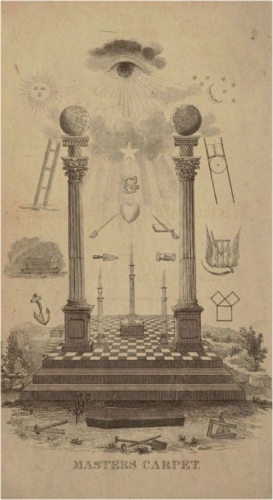
masonic scene
IMAGE LINKED: wellcome collection Attribution 4.0 International (CC BY 4.0)
The next question and answer have misled many thoughtful brethren as to the true meaning of Freemasonry.
It should be remembered that it is addressed to an E.A., who as yet has had hardly any indication what Masonry is anything else than a system of morality.
The first degree, for the most part, aims at teaching its members simply to be good men and true, and strictly to obey the moral law, but subsequent degrees teach much more than this.
Until a man has grasped these elementary lessons it is not only useless, but dangerous, to try to develop his intellectual facilities, which is the main exoteric purpose of the second degree.
For a Mason who has taken his third degree to give this answer as an explanation of what Freemasonry is shows that he has failed to grasp the inner meaning of even the second degree, much less of the third.
In short, this explanation by itself is only true when restricted to the first degree, for Freemasonry is much more than a mere system of morality, whilst even in the first degree the veil is very thin.
The Grand Principles, in modern language, may be interpreted as true comradeship, charity, and the search after truth, the latter phrase being better explained by the term the Mystic Quest after God.
The remaining questions are of a practical nature except that the phrase “perfect points of my entrance” is often somewhat of a mystery to the newly made brother.
Two interpretations of this phrase are sometimes given.
Firstly, that it refers to the Step, which is a tau cross, and means that we will trample under foot our animal passions. This is the manner in which we enter the lodge when once it is properly opened.

A tau cross (aka St Anthony of Egypt’s cross) by Alain Thebault
IMAGE LINKED: wellcome collection Attribution 4.0 International (CC BY 4.0)
But from the point of view of the candidate it cannot refer to this, for at his initiation he did not know the step, and so the other interpretation is the only one possible, namely, ” of, at and on.”
This is interpreted as meaning that the candidate entered pure Masonry of his own freewill. and accord, at the door of the lodge on the point of a sharp instrument (see lecture).
Having satisfactorily answered these questions the candidate is led to the W.M., representing the Spirit or Wisdom, and receives from him a password which will enable him to enter the lodge when it has been raised to the higher degree.
We have already in our first book explained briefly why passwords are necessary, but we will repeat our explanation for the convenience of any who have not yet read that book.
They are a relic of old world magic. The candidate goes out from a lodge in the first degree and re-enters it in the second degree.
In his absence the lodge is raised by a ceremony which, in the technical language of magic and the occult, “raises the vibrations” of those present to a higher key, and in consequence force is generated.
Those who have studied such matters know that a body of men who are all concentrating on a particular subject do generate a peculiar, subtle, but powerful force, which has not been actually defined by science but is loosely called magnetic.
In the old days of phenomenal magic certain words, when uttered in the correct tone, were believed to be in consonance with this “Power,” like a tuning fork is to a violin.
Therefore we give a password to the candidate to raise him quickly to the same “Power,” as the lodge.
Such passwords were usual in all great mystery rites, ancient or modern, and it is therefore not surprising to find them in Masonry.
It is worth noting that the Ancients were right when they charged the so-called Moderns, in the 18th Century, with having altered the words and passwords.
As a matter of fact they reversed them, and the word now given to an E.A. was originally given to an F.C., and vice versa, and the same fate befell the passwords.
Those foreign Grand Lodges who derive from England before about 1745 (for example, the French and the Dutch), still have the words and passwords in the old order, and in South Africa E.A.s and F.C.s of the Dutch Lodges are for this reason forbidden to visit the English Lodges until they have been made M.M.s.
The interpretation of this password will be given at a later point in the book; all we need do now is to stress the fact that, as it is represented in our lodge by candidate and word it is clearly associated with the J.W..
In the last book I pointed out that the J.W. represents in man, the body.
This therefore indicates that to the spiritually minded man the simplest necessities of life are plenty.
All he requires, as the Buddha taught, is sufficient to keep his body in health, whereas luxuries clog the soul and retard its upward progress.
I also pointed out in the last book that the J.W. represents God the Preserver, whose emblems in India, Mexico, etc., are candidate and word.
From the anthropological point of view, it is worth remembering that among primitive peoples God the Preserver is also the God of Vegetation and the Rain God.
He Who makes the corn to grow and provides food for his worshippers.
Thus we perceive that Freemasonry is perfectly logical in its use of this word.
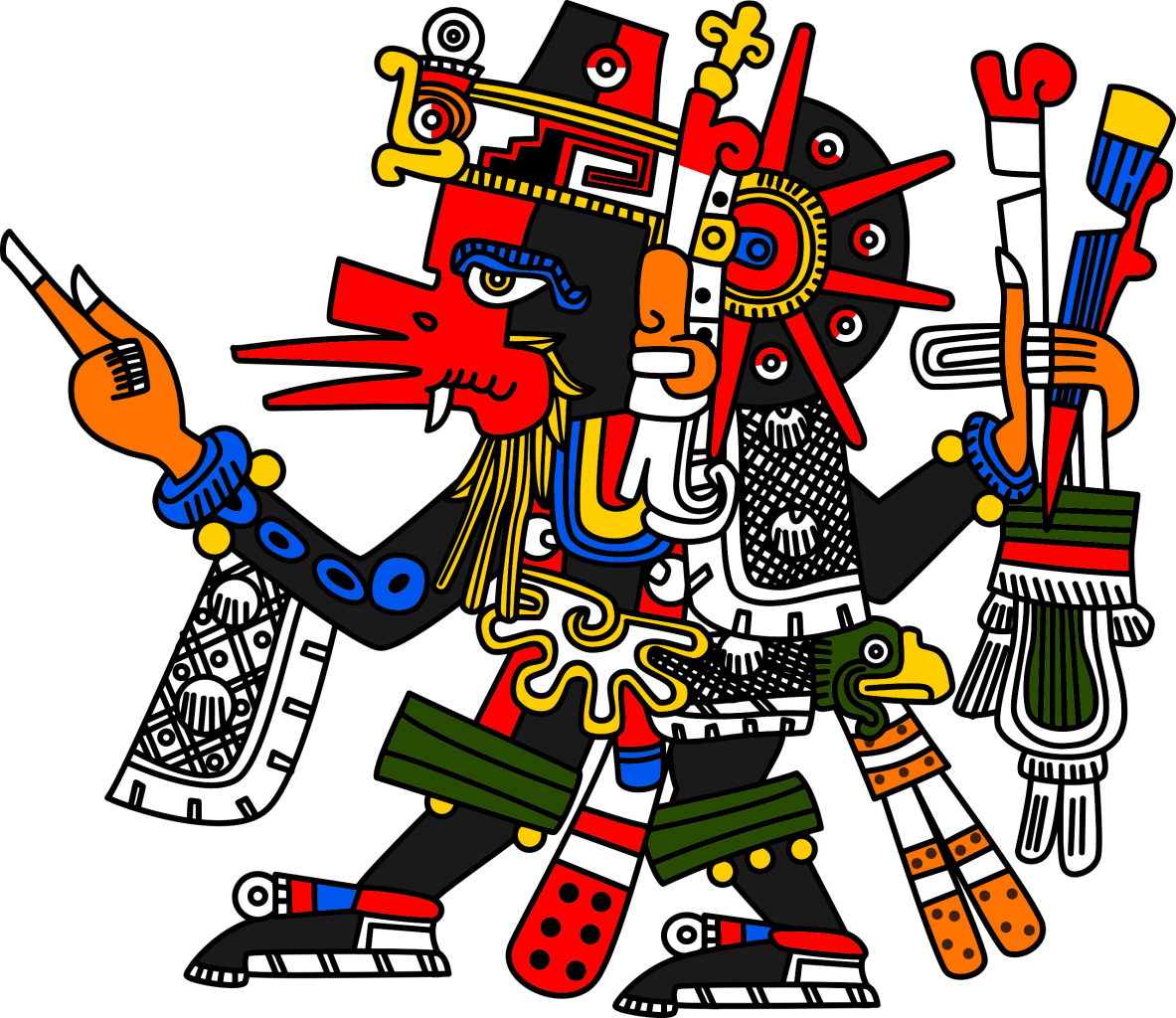
Quetzalcoatl By Unknown author – This image was created with Adobe Photoshop.
IMAGE LINKED: Wikimedia Attribution 4.0 International (CC BY 4.0)
Another fact of interest is that Quetzalcoatl, the Mexican Preserver, wears ears of corn in his hair when he is wounded by the giant of evil near to a fall of water and at that very instant makes the sign of a F.C. .
The candidate then departs to be prepared, and in the interval the lodge is raised to the second degree.
We will, however, consider the manner of his preparation before going on to the raising of the lodge. This varies in several details.
Most English workings are the same, but the Scotch and Irish have certain variations which are worthy of mention.
According to the Scotch rituals he brings into the lodge a square supported in his left hand but, as with us, the I.G. presents the angle of a square to his naked breast., although to the right breast instead of to the left breast.
In the Irish Lodges the same breast is made bare as with us, but he is still divested of all metals as he was in the first degree, and a cable tow is wound twice around his neck.
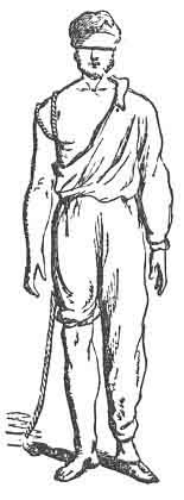
Thus it will be noted that everything save the breast is reversed. The Scotch, more logical, reverse even this.
In American rituals the Irish arrangement of the cable tow in the second degree is also found.
The reason for the deprivation of metals in the Irish ritual is because, as with us, the passwords have been reversed.
This has a deep symbolical meaning, and is logically correct, but I must defer the explanation to the next book.
Reverting to the English method of preparation, we must realise that the right side is the masculine side; it is also the stronger side.
It therefore implies, firstly, that we symbolically have passed out of the control of the women of the household and have gone on, as it were, to school.
In the first degree we were symbolically “Babes” or children, under the care of women.
In the second degree we are youths sent to be educated at school, and the whole exoteric meaning of the second degree is the training of the intelligence.
This corresponds to a boy’s training when he goes to a public school and is surrounded entirely by men.
At home, under his mother’s influence, he learnt only the simple lessons of morality; the lessons of the first degree.
The second meaning, i.e. the stronger side, is stressed in the Scotch rituals, where the candidate is afterwards told that he knelt on his right knee to take his obligation because the F.C. obligation is even more binding than the E.A.’s obligation.
This latter fact is also accentuated by the nature of the P., but this we will deal with later.
The candidate is not hoodwinked, because clearly he is no longer in that state of absolute darkness which enshrouded him when he first entered Masonry.
He has seen the light, and can never again return to the same darkness, although he may not as yet fully understand all that the light means, and it is to teach him the true nature of that light, which is really the light of God, that he takes his second degree.
In view of what has been written concerning the preparation in the first degree, no further explanation is necessary.
The Opening Of The Second Degree
The W.M. asks the J.W., representing the body, whether he is a F.C., to which the J.W. replies that he is, indicating the test to be applied.
Now, what does the square mean in this case ? It is not, be it noted, the W.M.’s square or tau cross, but it is an emblem of rectitude of conduct.
The right-angled square has always had this significance, and in many an Egyptian papyrus the Gods, when sitting in judgment on a soul, are depicted as seated on squares, implying that they are just judges.
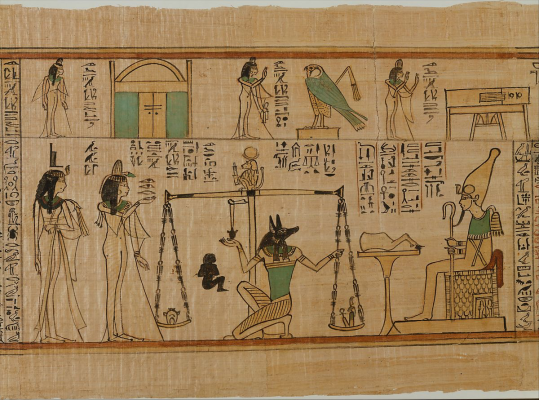
Osiris sits in judgement in a depiction of what is known as the ‘weighing of the heart’. From the Book of the Dead for the Chantress of Amun, Nany. C. 1050 B.C.
IMAGE LINKED: Met Museum Open Access licence 4.0 International (CC BY 4.0)
So the J.W.’s answer implies that he must be proved by his moral conduct in the physical world.
The F.C. degree indicates that the soul and body are now working in union, as is shown by the knocks, although, as yet, the purely spiritual faculties have little influence.
So, it naturally follows that in this stage of man’s development we have a right to expect that he will conform to all the moral laws, and to the higher dictates of his nature.
For example, he should have a kindly and charitable disposition.
If he has these, he is a Fellowcraft, but as yet we must not look for great spiritual insight.
It is through his body that a man is able to perform the moral duties of his station.
The S.W., or Soul, has little work to do at this stage, for it is through the body that we prove ourselves, and so it is the J.W. who is bidden to satisfy himself that all present are F.C
This being done, he confirms their testimony in his own person, and the fact that he literally is proved on the square must not be overlooked.
It should be noted that it is no longer the Creative Aspect of God Whom we call on, but the Preservative.
He who places limitations on us for our preservation, for, unless we conform to the rules of the Great Geometrician we cannot hope to be preserved.
It should be remembered that by these ceremonies the Lodge has been raised to a higher plane of spirituality.
Its spiritual and psychic vibrations are much higher, and to help the candidate to reach the same plane a password has been given him.
Article by: J. S. M. Ward
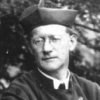
John Sebastian Marlow Ward (22 December 1885 – 1949) was an English author who published widely on the subject of Freemasonry and esotericism.
He was born in what is now Belize. In 1908 he graduated from the University of Cambridge with honours in history, following in the footsteps of his father, Herbert Ward who had also studied in history before entering the priesthood in the Anglican Church, as his father had done before him.
John Ward became a prolific and sometimes controversial writer on a wide variety of topics. He made contributions to the history of Freemasonry and other secret societies.
He was also a psychic medium or spiritualist, a prominent churchman and is still seen by some as a mystic and modern-day prophet.
Recent Articles: The Fellowcraft's Handbook
masonic knowledge
to be a better citizen of the world
share the square with two brothers

click image to open email app on mobile device



